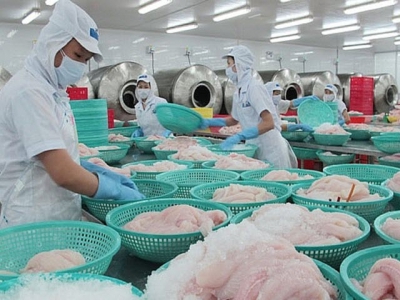Opportunity to export pangasius to 10 countries under CPTPP

The Comprehensive and Progressive Agreement for Trans-Pacific Partnership (CPTPP) took effect for Vietnam from January 14, 2019,bringing many opportunities for Vietnamese pangasius products.
Processing pangasius for export.
Tax advantages
According to the Vietnam Association of Seafood Exporters and Producers (VASEP), in 2018, pangasius export value to 10 CPTPP countries reached US$328.3 million, up 17.3% compared to the previous year. In particular, the export value into most countries achieved positive growth, except for two markets. Exports to Mexicodecreased by 4.65% and Peru decreased by 19.6%.With this momentum, in the first months of 2019, Pangasius exported to CPTPP countries continued to grow strongly.
CPTPP members commit to eliminating import duties on nearly all of their import tariffs. The majority of CPTPP countries apply a common import tax to all other partners, except for some countries such as Canada, Chile, Japan and Mexico that apply specific import tariffs for each CPTPP country.
Tariffs on most seafood products, including pangasius and basa fish, will be removed when the CPTPP Agreement comes into effect.Pangasius export enterprises may be optimistic to believe thatthere will be many opportunities for Vietnam in some traditional or potential markets such as Mexico, Japan or Chile.
Currently, Mexico is Vietnam's fifth largest pangasius export market (after China - Hong Kong, EU, US and ASEAN). In the first 4 months of 2019, the export value of pangasius and basa fish to this market reached US$40.8 million, up 31.5% compared to the same period of 2018.
This is also the largest pangasius export market in the Latin-American regionand in 10 CPTPP countries. According to the agreement, pangasius and basa fish products which are big export products to Mexicowill enjoy 0% tax in the third year after the CPTPP comes into effect.This is also an opportunity for enterprises to increase exports to this market in the future.
Japan has officially entered the top 10 largest pangasius export markets of Vietnam.With advantages from the CPTPP, this market is becoming a potential market of Vietnamese seafood enterprises, especially pangasius. In addition to the Vietnam-Japan and ASEAN-Japan FTAs, the CPTPP Agreement came into effect from January 2019, will also once again help Vietnamese shrimp increase its advantage in this market.
With the first two free trade agreements (FTAs), Vietnam - Japan and ASEAN - Japan, some of Vietnam's seafood products exported to Japan have been removed from the tariff barrier. With CPTPP, many previous seafood products which have not been committed to abolish taxes in the two FTAswill also enjoy a 0% tax rate when exporting to Japan.In particular, some seafood products will be entitled to 0% tax rate right after CPTPP takes effect, including pangasius products with current tax from 3.5 to10.5% will be exempted immediately.
Many potential markets
Although, compared to major seafood import markets in Latin – Americasuch as Mexico or Brazil, Chile is only a small consumer market of Vietnamese pangasius and basa fish. However, in recent years, especially after the Vietnam - Chile Free Trade Agreement (FTA) was signed at the end of 2011 and came into effect in early 2014, the export of pangasius and basa fish to this market has seenmany changes,in which the people of this country have gradually learnedaboutpangasius and basa fish.
Currently, with the import tax advantage of 0% for frozen fillet pangasius and basafish (HS 030462), through Chilean distribution channels, Vietnamese products will likely not only be consumed in this country, but also introducedand presented in other countries in the region.
In addition to the major exporting countries, there must be some potential markets in the group of countries participating in the CPTPP such as Canada, Australia, Singapore, and Malaysia. These markets are being evaluated with many opportunities to increase export market share in the future. Pangasius and basa fish exports to these countries also saw positive growth, such as Canada increased by 19.5%; Australia increased by 34.4%, Singapore increased by 20.7%, and Malaysia increased by 72.2% over the previous year.
Along with the challenges that CPTPP brings to Vietnamese pangasius export enterprises, there are many opportunities ahead. Therefore, enterprises need to study the benefits that this agreement brings in terms of tariffs to seize opportunities and continue to boldly increase exports.
Có thể bạn quan tâm
Phần mềm

Phối trộn thức ăn chăn nuôi

Pha dung dịch thủy canh

Định mức cho tôm ăn

Phối trộn phân bón NPK

Xác định tỷ lệ tôm sống

Chuyển đổi đơn vị phân bón

Xác định công suất sục khí

Chuyển đổi đơn vị tôm

Tính diện tích nhà kính

Tính thể tích ao hồ



 Namibia seeks to expand fledgling aqua sector
Namibia seeks to expand fledgling aqua sector  Aquatic firm sets to withdraw from two sub…
Aquatic firm sets to withdraw from two sub…